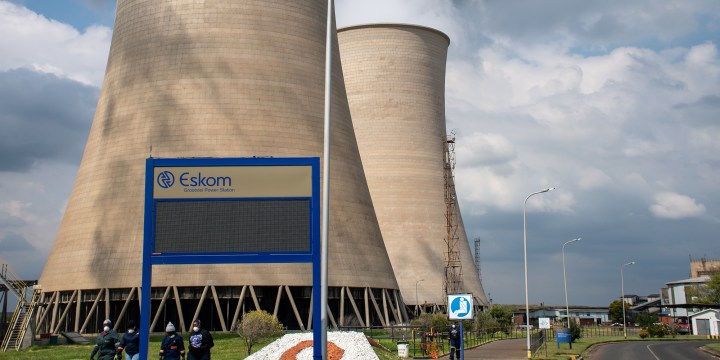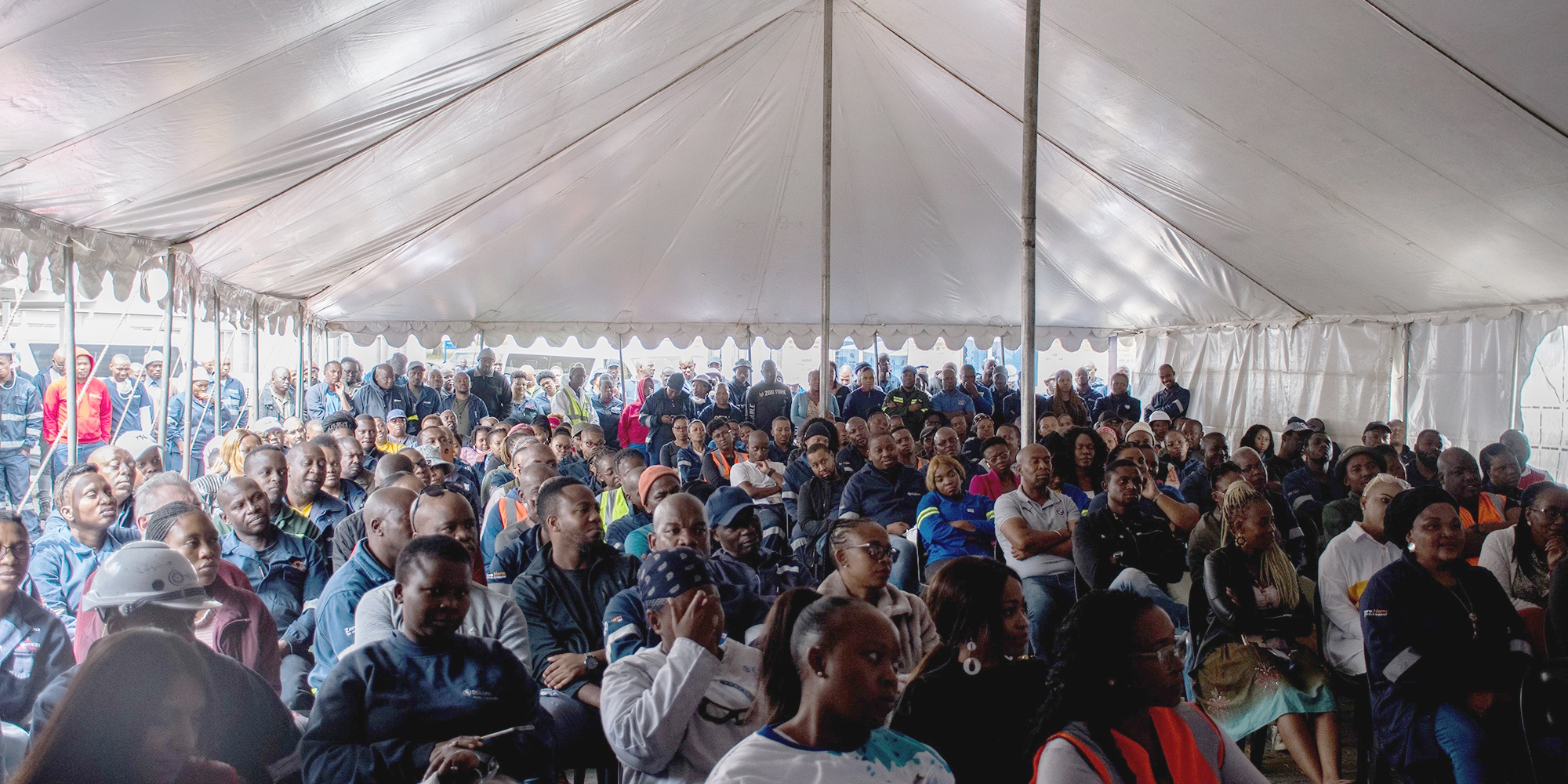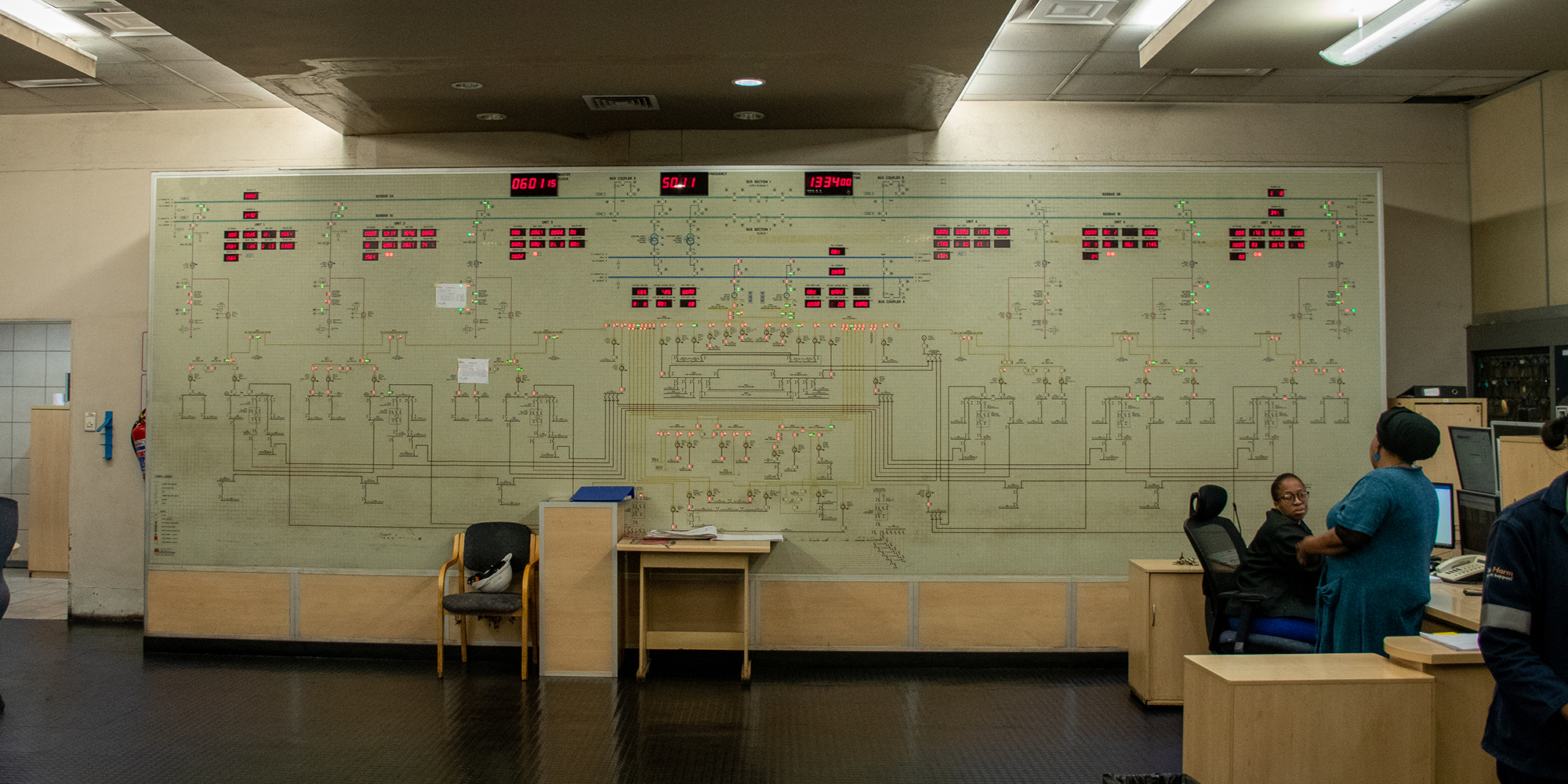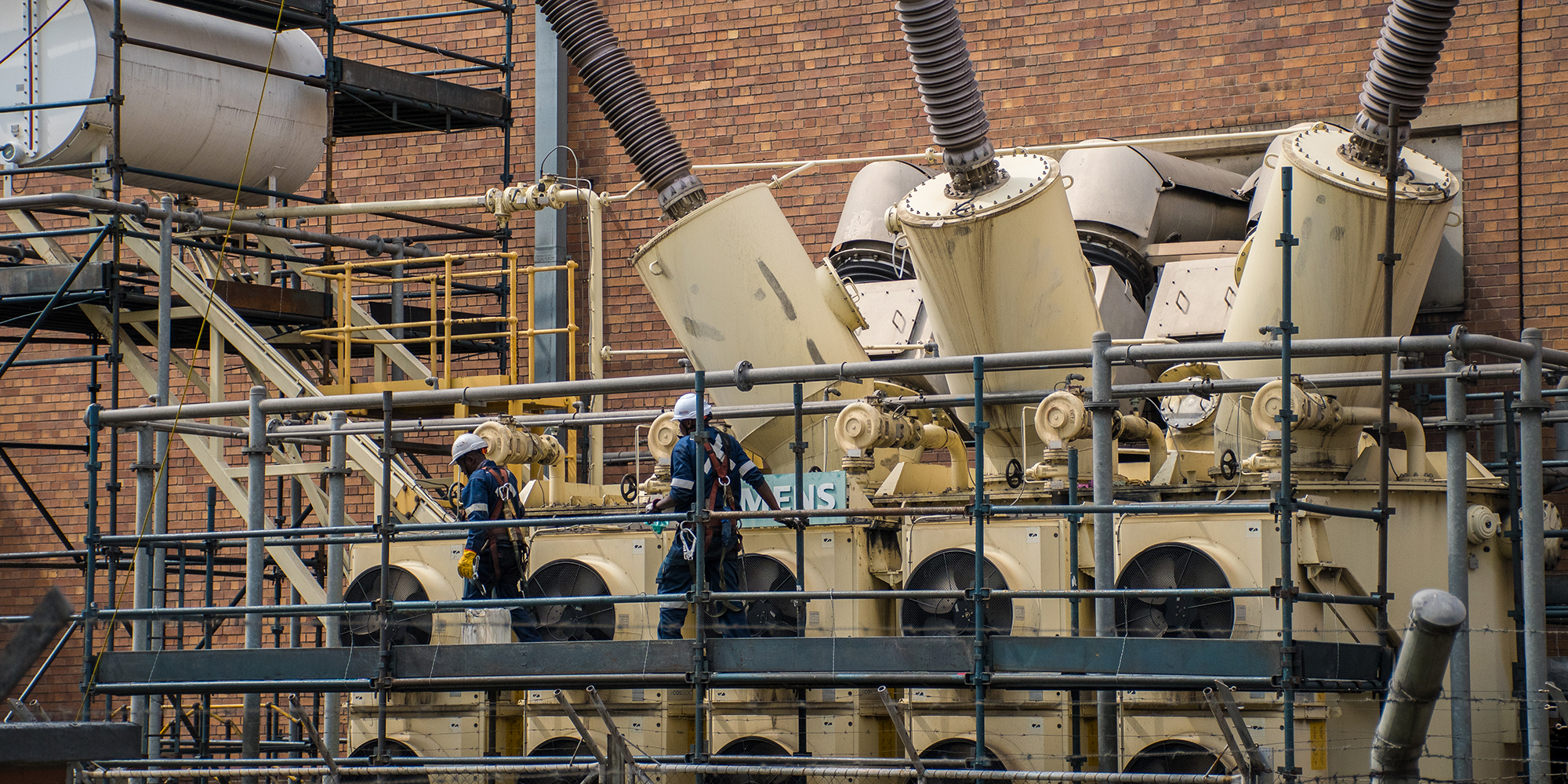POWER CRISIS
Electricity minister Kgosientsho Ramokgopa to push for extending life of ageing coal-fired power station

‘Why do you want to decommission things that work?’ asked Minister in the Presidency responsible for electricity Kgosientsho Ramokgopa during his address to employees of Grootvlei Power Station in Mpumalanga on Tuesday, while on one of his visits to Eskom’s power plants.
Grootvei is one of South Africa’s oldest coal-fired power stations, with its first unit commissioned in 1969. As Eskom coal plants were built for a 50-year lifespan, Grootvlei is meant to be decommissioned in 2027.
But, in the middle of a power crisis, with Eskom saying it is 6,000 megawatts (MW) short, the new minister of electricity Kgosientsho Ramokgopa told more than 350 workers at Grootvlei on Tuesday, just under half of whom live in the area:

Minister in the Presidency for electricity Kgosientsho Ramokgopa addresses Grootvlei Power Station employees during a site visit on 28 March 2023. (Photo: Julia Evans)
“Grootvlei is an important player in the resolution of load shedding. We are searching for the megawatts and Grootvlei’s life can’t be up to 2027 because this country’s future goes beyond 2027,” which was met by applause.
Is it possible to extend the life of an old coal plant?
Ramokgopa explained to Daily Maverick after his speech, “I think we must do everything possible for us to get the megawatts where there’s an existing fleet, because it’s already a sunk cost.”
Asked about the environmental and economic viability of extending the life of Grootvlei, said to have exceeded its design life for turbines, according to a leaked report from 2015 (see graph below), Ramokgopa said he was not saying the decision had been made, but that every option should be considered.


Grootvlei Power Station employees listen to the Minister in the Presidency for electricity, Kgosientsho Ramokgopa, address them on a 28 March 2023 site visit. (Photo: Julia Evans)
Ramokgopa said SA needed to consider the aggression with which it decarbonises, “because that aggression can undermine your economic aspirations”, and extending the life of a plant would provide a window to build new generation capacity.
He said if it could be shown that energy lost from decommissioning could be replaced, that was good, “but in the absence of an alternative, we already have an asset. So let’s see how best we can maximise that asset.”
He said this was a decision that could be made only at the level of Cabinet and Eskom, but he would make a case for it.
What are the downsides of extending?
Grootvlei was mothballed in the early 1990s because South Africa had excess power at the time. Three of the units were resurrected between 2008 and 2013 because SA didn’t have enough power. Since then, the station’s end-of-life date has been extended by five years — from 2022 to 2027.
Jesse Burton from the Energy Systems research group at UCT, who provides analysis and policy advice on coal transitions in South Africa, told Daily Maverick, “Continuing to run very old, inefficient and polluting plants because we are in a supply crisis might be a necessary short-term option, but it highlights the failure in energy planning.

The control room in Grootvlei Power Station, a coal-fired power plant in Mpumalanga that has a generation capacity of 600MW. (Photo: Julia Evans)
“There is no economic reason to extend the running of a plant that was commissioned in the ’60s/’70s except as an emergency measure, and if it were still needed as an emergency option after 2027 then that could only mean that SA has failed to build enough new affordable energy and the SA power system is in an even graver crisis.”
Engineer and energy analyst Chris Yelland questioned whether a coal plant like Grootvlei, only built to last 50 years, would need to have infrastructure replaced. Grootvlei’s three units have the built capacity to contribute just under 600MW to the grid (each of the six units can contribute about 200MW, and three units are active).
The day the minister visited Grootvlei, he commended the employees for having an Energy Availability Factor (EAF) of over 90% for the two operational units (one unit is out for maintenance).
But Yelland said looking at the EAF at a particular point in time was meaningless; you had to look at the EAF over typically a month or a year.
Tshepiso Temo, the general manager of Grootvlei Power Station, said that before the life of Grootvlei was extended to 2027, they ran the units hard and didn’t do regular maintenance, and the EAF was between 60 and 65% which, she said, was good for an old plant.

Eskom employees work on a generator transformer that steps up the voltage of the generator at Grootvlei Power Station. (Photo: Julia Evans)
But in 2021, when it was decided to extend the life until 2027, they introduced an “outage” schedule, where every 18 months they shut down one unit at a time for 88 days for inspection and repairs. So with one unit off for maintenance, the EAF dropped to 50.88% over the past financial year.
‘You can’t do maintenance forever’
“Komati shut down because they were forced to shut down. They no longer complied with the legal requirements in terms of boiler plant in the high-pressure piping,” said Yelland about the first coal-fired plant to be decommissioned at the end of last year.
“There are legal restrictions, you can’t just do ongoing maintenance forever. At some point, you’ve got to do a life extension, which might require replacing piping, or high-pressure systems.”
Burton said, “I think it is very unlikely that life-extending these older plants is economically feasible. And operating them without investment would eventually make them unsafe, and without environmental retrofits would make the people around the plants unsafe.”
“For every option… there’s a downside,” said Ramokgopa on the decision to decommission, but added that Groovlei was operating within its environmental licensing parameters.
While this is true today, with Groovlei’s emissions of air pollutants below SA’s national Minimum Emission Standards (MES), if the power station extends past 2027, that will not be the case.
 Temo said, “If you look at the performance in terms of emissions in generation, as a whole, Grootvlei is one of the top-performing stations because we’re already complying with the future requirement, 50mg for particulate matter.”
Temo said, “If you look at the performance in terms of emissions in generation, as a whole, Grootvlei is one of the top-performing stations because we’re already complying with the future requirement, 50mg for particulate matter.”
When the three units at Grootvlei were resurrected, the plant was retrofitted with emission abatement technology to ensure compliance.
Temo explained that the installed fabric filter plants help decrease particulate matter emissions, which is why they are well below the limit.
However, particulate matter is not the only air pollutant that affects health — coal-fired power plants, along with emitting carbon dioxide that contributes to global warming, also emit sulphur dioxide (SO2) and nitrous oxide.
‘The single most important standard’
Lauri Myllyvirta, the lead analyst at the Centre for Research on Energy and Clean Air (Crea), explained: “The single most important standard is the standard for sulphur dioxide emissions, because those are the ones that are responsible for the vast majority of the health impacts from the power plants.”
There are two important emission standards to take note of. The “2015 limit” — what analysts call the “extremely lenient” standards, meant to be met in 2015 — and the “2020 limits”, meant to be met in 2020 — which, compared internationally are still dismal, but stricter than previous limits.
The “2015 standards” limit SO2 emissions to 3,500mg/Nm3. The “2020 standards” limit SO2 emissions to 1,000mg/Nm3.
By contrast, the European Union requires new coal plants to limit SO2 emissions to 55mg/Nm3 (when converted to the measurement standard used in South Africa), while China’s limit is 25mg/Nm3.
Read more in Daily Maverick: Eskom emits more sulphur dioxide than any power company in the world — latest research
Myllyvirta co-authored the Crea report, Health impacts of Eskom’s non-compliance with minimum emissions standards, which found that if Eskom fully complied with the MES at all plants meant to operate beyond 2030, that would avoid about 2,300 deaths per year caused by air pollution.
Read more in Daily Maverick: Something stinks – Eskom’s uncontrolled pollution emissions cost thousands of lives and billions of rands
Robyn Hugo, director of climate change engagement at shareholder activist organisation Just Share, previously told Our Burning Planet: “The minimum emission standards (MES), which Sasol and Eskom argue are so onerous, are in fact hopelessly weak and inadequate. The SO2 MES are some 28 times weaker than China’s, and 10 times weaker than India’s.”
But here’s the crazy part — Eskom isn’t even complying with our newer “hopelessly weak” standards, that were meant to be met in 2020.
There’s no way for our current plants to emit less than 1,000mg/Nm3 (“2020 limit”) without retrofitting plants with emission abatement technology, like the flue gas desulphurisation (FDG) technology, that decreases SO2 emissions.
Right now, the only power station in SA that has an FDG installed is Kusile. But because the FDG has been causing issues, exacerbating load shedding, Eskom has been allowed to temporarily bypass the FDG at three units while it conducts repairs at the plant (meaning their SO2 emissions are now higher).
It’s as the minister of mineral resources and energy, Gwede Mantashe, often says: “You can breathe clean air, but in darkness.”
So Eskom asked for an extension for its plants to meet the newer standards, which was granted. Stations that were planned to operate beyond 2030 have to meet the 1,000mg/Nm3 SO2 limit by 2025, according to current atmospheric emission licenses.
And those planned for shutdown — Komati, Camden, Grootvlei — were granted a suspension of compliance, meaning they can emit up to 3,500mg until they close.
But if Grootvlei stays open beyond 2027, it would have to comply with the new standards, which means an FDG would have to be installed.

Members of the South African National Defence Force at the perimeter of Grootvlei Power Station, Mpumalanga, on 28 March 2023. (Photo: Julia Evans)
Ntombi-Zodwa Maphosa, an attorney with the Climate Change and Pollution Programme at the Centre for Environmental Rights (CER), explained that Eskom had applied for postponements and suspensions of compliance with the “2020 standards”, so the CER lodged an appeal with the minister of forestry, fisheries and environment, Barbara Creecy, challenging the decision that granted the suspension.
For Grootvlei, Maphosa said, “Our main contention in the appeal is that it was granted this suspension without it having provided a detailed and clear decommissioning schedule as required by the law.”
As a result, Creecy set up a forum to advise her about all the applications for suspensions and postponements. The forum is meant to give recommendations in July.
Maphosa said in their engagements with the forum they raised the “Deadly Air” judgment from March 2022, which confirmed that air pollution in the Highveld Priority Area breaches the constitutional right to an environment not harmful to health or wellbeing, and that government must hold big polluters to account.
“We do understand it’s a very complex issue… but we’ve always said that people shouldn’t have to choose between electricity and their health… So, we hope that the minister will make the right decision, because these standards are there to protect people’s health,” said Maphosa.
Inspiring hope?
Ramokgopa told the workers at Grootvlei: “South Africa needs each and every megawatt possible to be able to take us out of this situation and help the economy to grow. [You] keep the three units working, and we will make sure that we fight the fight for those three other units that are out of operation to come back.” This was met by applause and cheering.
Temo said Grootvlei has the infrastructure to dispatch power produced from renewables and Eskom owns about 200 hectares around the plant where renewables could be built, “but what SA needs now is immediately available power.
“I don’t want to become another Komati where there are zero megawatts produced — rather run it in parallel. And it’ll also give hope to the workers, to say that we are transitioning. After coal there is hope.” DM/OBP
For tickets to Daily Maverick’s The Gathering Earth Edition, click here.



















 Become an Insider
Become an Insider
Cute, he thinks eskom is working.
We need more than hope; we need clean, renewable energy. The biggest obstacle to that to date has been the ANC, its cadres pilfering and sabotage and sheer incompetence. Viva, ANC, Viva.
Heaven helps us. This minister brags about 90% EAF. Two units do this, ignoring that a third unit is out for planned maintenance and the three other units are FUBAR.
Applause and cheering? Give that man a Bells, the perfect spin doctor. We await winter, though possibly without the applause and cheering.
The fifty year rule that is said to govern the lifespan of powerstations is not based on any engineering criteria. It was a thumbsuck by those building the infrastructures at the time, the 1950s 60s and 70s who had no idea of how the then nascent technologies would snowball into the future. There was little past experience on which to base such a rule, so a round half century sounded OK. To now say Cabinet must decide on a fifty year rule is the blind leading the blind
Buried in the SANRAL rules is also a statement that bridges are designed to last 50 years, which was based on similar vague factors. If that rule was to have been followed SANRAL would now be replacing thousands of bridges but no such thing is happening
Fifty year rules are meaningless and should be removed from the statutes, the focus should be on obsolesence factors, well described in the article, and dealing with those to extend lifespans